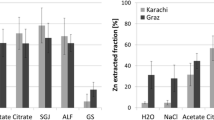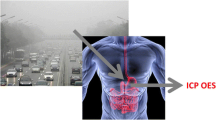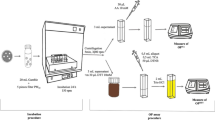Abstract
In vitro tests simulating the elements release from inhaled urban particulate matter (PM) with artificial lung fluids (Gamble’s and Hatch’s solutions) and simulated gastric and pancreatic solutions were applied for an estimation of hazardous element (As, Cd, Cr, Hg, Mn, Ni, Pb and Zn) bio-accessibility in this material. An inductively coupled plasma optical emission spectrometry (ICP-OES) and an inductively coupled plasma mass spectrometry (ICP-MS) were employed for the element determination in extracted solutions. The effect of the extraction agent used, extraction time, sample-to-extractant ratio, sample particle size and/or individual element properties was evaluated. Different patterns of individual elements were observed, comparing Hatch’s solution vs. simulated gastric and pancreatic solutions. For Hatch’s solution, a decreasing sample-to-extractant ratio in a PM size fraction of <0.063 mm resulted in increasing leached contents of all investigated elements. As already proved for other operationally defined extraction procedures, the extractable element portions are affected not only by their mobility in the particulate matter itself but also by the sample preparation procedure. Results of simulated in vitro tests can be applied for the reasonable estimation of bio-accessible element portions in the particulate matter as an alternative method, which, consequently, initiates further examinations including potential in vivo assessments.
Similar content being viewed by others
References
Žalud P, Száková J, Sysalová J, Tlustoš P (2012) Factors influencing uptake of contaminated particulate matter in leafy vegetables. Cent Eur J Biol 7:519–530
Rasmussen PE et al (2008) Influence of matrix composition on the bioaccessibility of copper, zinc, and nickel in urban residential dust and soil. Hum Ecol Risk Assess: Int J 14:351–371
Pupíková Z, Száková J, Sysalová J, Mestek O, Tlustoš P (2012) Direct and subsequent effects of contaminated urban particulate matter on risk element mobility and plant-availability in soil. Pol J Environ Stud 21:1807–1815
Moloi K, Viksna A, Lindgren ES, Standzenieks P (2002) Sequential leaching of trace elements in fine-particle aerosol samples on Teflon filters. X-Ray Spectrom 31:27–34
Sysalová J, Száková J, Goessler W, Tremlová J (2011) Methodological study of extraction procedures applied to urban particulate matter. Cent Eur J Chem 9:1071–1079
Ruby MV, Davis A, Schoof R, Eberle S, Sellstone CM (1996) Estimation of lead and arsenic bioavailability using a physiologically based extraction test. Environ Sci Technol 30:422–430
Lee SW, Lee BT, Kim JY, Kim KW, Lee JS (2006) Human risk assessment for heavy metals and as contamination in the abandoned metal mine areas, Korea. Environ Monit Assess 119:233–244
Hettiarachchi GM, Pierzynski GM, Oehme FW, Sonmez O, Ryan JA (2003) Treatment of contaminated soil with phosphorus and manganese oxide reduces lead absorption by Sprague-Dawley rats. J Environ Qual 32:1335–1345
Juhasz AL, Weber J, Naidu R, Gancarz D, Rofe A, Todor D, Smith E (2010) Determination of cadmium relative bioavailability in contaminated soils and its prediction using in vitro methodologies. Environ Sci Technol 44:5240–5247
Paradelo R et al (2011) Distribution and availability of trace elements in municipal solid waste composts. J Environ Monit 13:201–211
Chou JD, Wey MY, Liang HH, Chang SH (2009) Biotoxicity evaluation of fly ash and bottom ash from different municipal solid waste incinerators. J Haz Mat 168:197–202
Turner A, Price S (2008) Bioaccessibility of platinum group elements in automotive catalytic converter particulates. Environ Sci Technol 42:9443–9448
Nunez RP, Rey RD, Menduina ABM, Silva MTB (2007) Physiologically based extraction of heavy metals in compost: preliminary results. J Trace Elem Med Biol 21:83–85
Rieuwerts JS, Searle P, Buck R (2006) Bioaccessible arsenic in the home environment in southwest England. Sci Total Environ 371:89–98
Colombo C, Monhemius AJ, Plant JA (2008) The estimation of the bioavailabilities of platinum, palladium and rhodium in vehicle exhaust catalysts and road dusts using a physiologically based extraction test. Sci Total Environ 389:46–51
Tremlová J, Száková J, Sysalová J, Tlustoš P (2013) Bioavailability of arsenic, cadmium, iron and zinc in leafy vegetables amended with urban particulate matter suspension. J Sci Food Agric 93:1378–1384
Iwai K, Mizuno S, Miyasaka Y, Mori T (2005) Correlation between suspended particles in the environmental air and causes of disease among inhabitants: cross-sectional studies using the vital statistics and air pollution data in Japan. Environ Res 99:106–117
Herting G, Wallinder IO, Leygraf C (2007) Metal release from various grades of stainless steel exposed to synthetic body fluids. Corros Sci 49:103–111
Pelucchi C, Negri E, Gallus S, Boffetta P, Tramacere I, La Vecchia C (2009) Long-term particulate matter exposure and mortality: a review of European epidemiological studies. BMC Public Health 9:453
Bargagli E, Monaci F, Bianchi N, Bucci C, Rottoli P (2008) Analysis of trace elements in bronchoalveolar lavage of patients with diffuse lung diseases. Biol Trace Elem Res 124:225–235
Sunil VR et al (2009) Pulmonary effects of inhaled diesel exhaust in aged mice. Toxicol Appl Pharmacol 241:283–293
Morgan DL et al (1997) Comparative pulmonary absorption, distribution, and toxicity of copper gallium diselenide, copper indium diselenide, and cadmium telluride in Sprague-Dawley rats. Toxicol Appl Pharmacol 147:399–410
Kodavanti UP, Hauser R, Christiani DC, Meng ZH, McGee J, Ledbetter A, Richards J, Costa DL (1998) Pulmonary responses to oil fly ash particles in the rat differ by virtue of their specific soluble metals. Toxicol Sci 43:204–212
Moss OR (1979) Simulants of lung interstitial fluid. Health Phys 36:447–448
Hatch EG (1992) Comparative biochemistry of airway lining fluid. In: Parent RA (ed) Comparative biology of the normal lung, 1st edn. CRC, Boca Raton, p 617
Berlinger B, Ellingsen DG, Náray M, Záray G, Thomassen Y (2008) A study of the bio-accessibility of welding fumes. J Environ Monit 10:1448–1453
Hlavay J, Prohaska T, Weisz M, Wenzel WW, Stingeder GJ (2004) Determination of trace elements bound to soils and sediment fractions. Pure Appl Chem 76:415–442
Sonmez O, Pierzynski GM (2005) Phosphorus and manganese oxides effects on soil lead bioaccessibility: PBET and TCLP. Water Air Soil Pollut 166:3–16
Yang JK, Barnett M, Jardine PM, Brooks SC (2003) Factors controlling the bioaccessibility of arsenic(V) and lead(II) in soil. Soil Sedim Contam 12:165–179
Tremlová J, Száková J, Tlustoš P (2010) An assessment of possible effect of risk elements contained in soil on human organism (in Czech). Chem Listy 104:349–352
Kašparovská K, Száková J, Sysalová J, Tlustoš P, Svoboda P (2013) In-vitro bioavailability of hazardous elements from inhaled urban particulate matter (in Czech). Chem Listy 107:313–317
Sysalová J, Sýkorová I, Havelcová M, Száková J, Trejtnarová H, Kotlík B (2012) Toxicologically important trace elements and organic compounds investigated in size-fractionated urban particulate matter collected near the Prague highway. Sci Total Environ 437:127–136
Intawongse M, Dean JR (2008) Use of the physiologically-based extraction test to assess the oral bioaccessibility of metals in vegetable plants grown in contaminated soil. Environ Pollut 152:60–72
Smichowski P, Gómez D, Frazzoli C, Caroli S (2008) Traffic-related elements in airborne particulate matter. Appl Spectrosc Rev 43:23–49
Ljung K, Selinus O, Otabbong E, Berglund M (2006) Metal and arsenic distribution in soil particle sizes relevant to soil ingestion by children. Appl Geoch 21:1613–1624
Boszke L, Kowalski A, Astel A, Baraňski A, Gworek B, Siepak J (2008) Mercury mobility and bioavailability in soil from contaminated area. Environ Geol 55:1075–1087
Pandey SK, Kim KH, Brown RJC (2011) Measurement techniques for mercury species in ambient air. Trends Anal Chem 30:899–917
European Community, Council Directive 96/62/EC of 27 September 1996 on ambient air quality assessment and management. Off J, L296, 55
Acknowledgments
The authors thank for the financial support of the GA ČR projects 521/09/1150 and P503/12/0682
Author information
Authors and Affiliations
Corresponding author
Rights and permissions
About this article
Cite this article
Sysalová, J., Száková, J., Tremlová, J. et al. Methodological Aspects of In Vitro Assessment of Bio-accessible Risk Element Pool in Urban Particulate Matter. Biol Trace Elem Res 161, 216–222 (2014). https://doi.org/10.1007/s12011-014-0101-x
Received:
Accepted:
Published:
Issue Date:
DOI: https://doi.org/10.1007/s12011-014-0101-x




